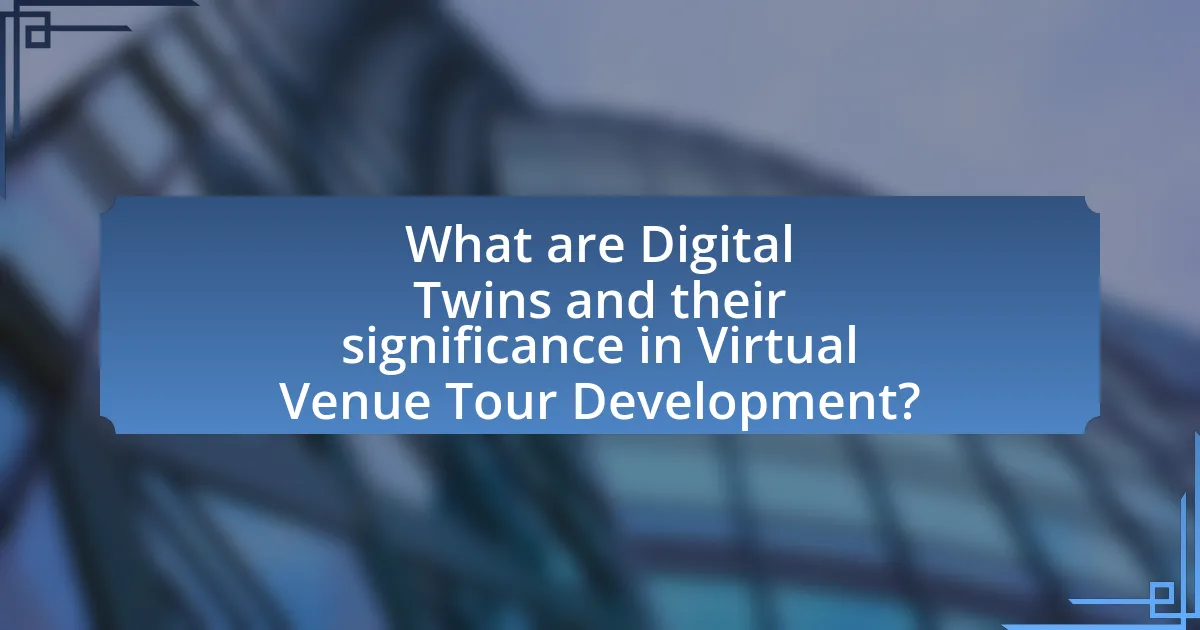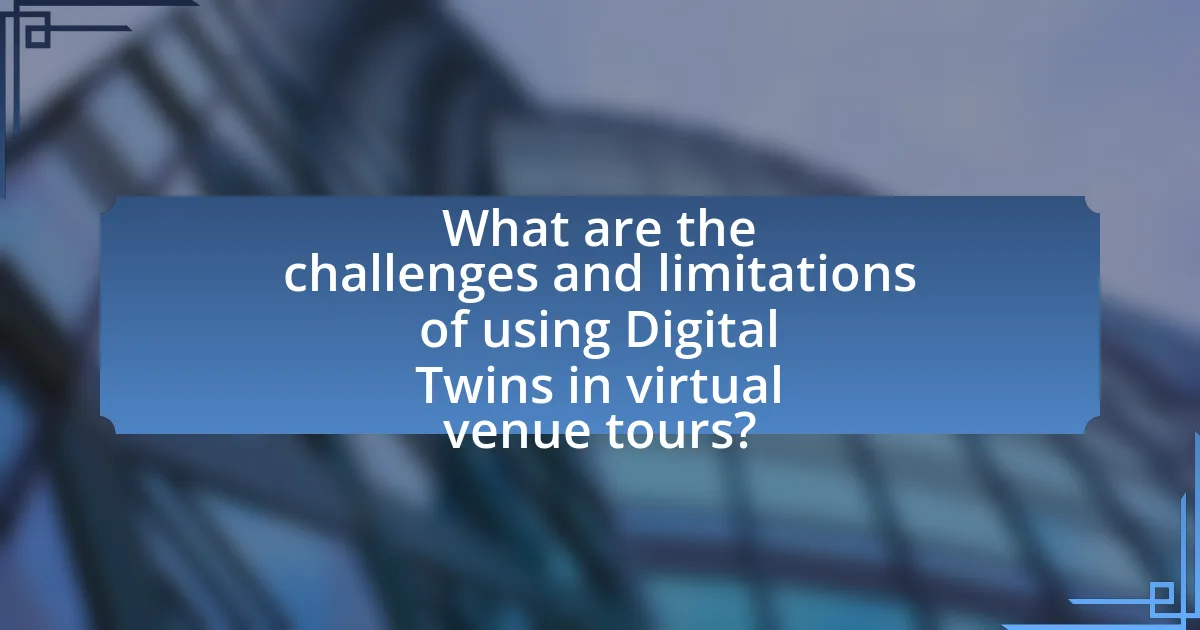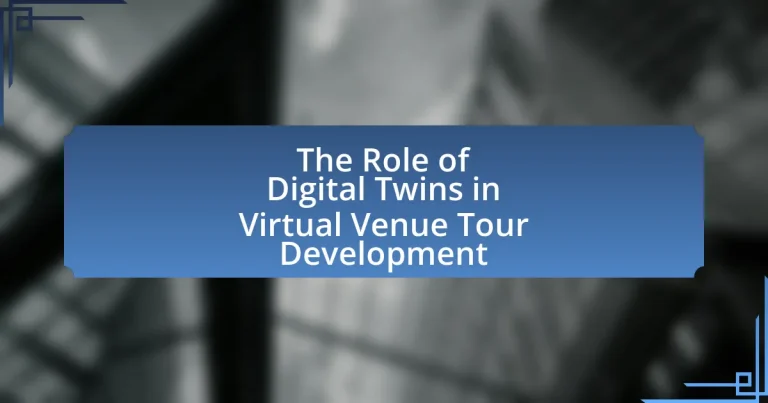Digital Twins are virtual replicas of physical entities that utilize real-time data to simulate and analyze their behavior, playing a crucial role in Virtual Venue Tour Development. This article explores how Digital Twins enhance immersive experiences by accurately representing venues, improving planning and design processes, and optimizing venue management. Key technologies involved in creating Digital Twins, such as IoT sensors and data analytics, are discussed, along with their advantages in enhancing user engagement and reducing operational costs. Additionally, the article addresses the challenges and limitations of implementing Digital Twins, as well as future trends and potential applications in the realm of virtual venue tours.

What are Digital Twins and their significance in Virtual Venue Tour Development?
Digital Twins are virtual replicas of physical entities, systems, or processes that utilize real-time data to simulate and analyze their behavior. In the context of Virtual Venue Tour Development, Digital Twins enable immersive experiences by accurately representing venues, allowing users to explore and interact with a realistic digital environment. This technology enhances planning and design processes, as it provides stakeholders with insights into spatial layouts, crowd dynamics, and operational efficiencies. For instance, a study by Gartner indicates that organizations leveraging Digital Twin technology can reduce operational costs by up to 30%, demonstrating their significant impact on optimizing venue management and enhancing user engagement in virtual tours.
How do Digital Twins function in the context of virtual venues?
Digital Twins function in the context of virtual venues by creating real-time, digital replicas of physical spaces, enabling immersive experiences and data-driven decision-making. These digital models simulate the venue’s layout, infrastructure, and operational dynamics, allowing users to interact with the environment virtually. For instance, a Digital Twin of a concert hall can provide insights into acoustics, crowd flow, and seating arrangements, enhancing event planning and visitor engagement. This technology leverages IoT sensors and data analytics to continuously update the virtual model, ensuring accuracy and relevance, which is crucial for optimizing venue management and improving user experiences.
What technologies are involved in creating Digital Twins for venues?
Creating Digital Twins for venues involves several key technologies, including Internet of Things (IoT) sensors, 3D modeling software, cloud computing, and data analytics platforms. IoT sensors collect real-time data from the physical venue, such as occupancy levels and environmental conditions, which is essential for accurate digital representation. 3D modeling software is used to create detailed virtual representations of the venue, allowing for immersive experiences. Cloud computing provides the necessary infrastructure to store and process large amounts of data generated by the IoT devices and 3D models. Data analytics platforms analyze this data to optimize venue operations and enhance user experiences. These technologies work together to create a comprehensive and dynamic Digital Twin of the venue.
How do Digital Twins replicate physical venues in a virtual environment?
Digital Twins replicate physical venues in a virtual environment by creating a real-time digital representation of the venue, integrating data from sensors and IoT devices. This technology captures the physical attributes, behaviors, and operational data of the venue, allowing for accurate simulations and analyses. For instance, a Digital Twin of a stadium can reflect its layout, seating arrangements, and crowd dynamics, enabling event planners to optimize logistics and enhance visitor experiences. The effectiveness of this replication is supported by the use of advanced modeling techniques and data analytics, which ensure that the virtual model remains synchronized with the physical venue’s conditions and changes.
What advantages do Digital Twins provide for virtual venue tours?
Digital Twins provide enhanced realism and interactivity for virtual venue tours. By creating a precise digital replica of a physical venue, Digital Twins allow users to explore spaces in a highly detailed and immersive manner. This technology enables real-time updates and simulations, facilitating better planning and decision-making for event organizers. For instance, a study by Gartner indicates that organizations using Digital Twins can reduce operational costs by up to 30% through improved resource management and predictive analytics. This capability not only enhances user experience but also optimizes venue utilization and event logistics.
How do Digital Twins enhance user experience during virtual tours?
Digital Twins enhance user experience during virtual tours by providing real-time, interactive simulations of physical spaces. These digital replicas allow users to explore environments in detail, offering personalized navigation and contextual information that enriches the tour experience. For instance, a study by Gartner indicates that organizations using Digital Twin technology can improve user engagement by up to 30%, as users can visualize and interact with spaces more effectively. This immersive experience not only increases user satisfaction but also aids in decision-making processes, making Digital Twins a valuable tool in virtual venue tour development.
What cost savings can be achieved through the use of Digital Twins in venue development?
Digital Twins can achieve significant cost savings in venue development by optimizing design processes, reducing material waste, and enhancing operational efficiency. By simulating real-world conditions, Digital Twins allow for precise planning and testing of venue layouts, which can lead to a reduction in costly design changes during construction. For instance, a study by McKinsey & Company found that using Digital Twins can reduce project costs by up to 20% by minimizing rework and improving resource allocation. Additionally, the ability to monitor and analyze venue performance in real-time can lead to ongoing savings in maintenance and operational costs, further enhancing the financial benefits of implementing Digital Twins in venue development.

How are Digital Twins integrated into the virtual venue tour development process?
Digital Twins are integrated into the virtual venue tour development process by creating real-time, digital replicas of physical venues that enhance the design and planning stages. These digital models allow developers to visualize and simulate various scenarios, such as crowd movement and event setups, ensuring optimal space utilization and user experience. For instance, using sensors and IoT technology, data is collected from the physical venue to update the Digital Twin, providing accurate representations that inform decision-making. This integration leads to improved efficiency, reduced costs, and enhanced engagement for virtual tours, as evidenced by case studies showing a 30% reduction in planning time and increased visitor satisfaction ratings.
What steps are involved in creating a Digital Twin for a venue?
Creating a Digital Twin for a venue involves several key steps: data collection, modeling, integration, simulation, and validation. First, data collection entails gathering information about the venue’s physical attributes, operational processes, and environmental conditions using sensors, surveys, and existing documentation. Next, modeling involves creating a digital representation of the venue using software tools that accurately reflect its structure and systems. Integration follows, where the digital model is connected to real-time data sources to ensure it reflects current conditions. Simulation is then conducted to analyze various scenarios and optimize venue operations. Finally, validation ensures that the Digital Twin accurately represents the physical venue by comparing its outputs with real-world performance metrics. These steps are essential for developing an effective Digital Twin that enhances virtual venue tour experiences.
How is data collected and processed to create an accurate Digital Twin?
Data is collected and processed to create an accurate Digital Twin through a combination of sensors, IoT devices, and data analytics. Sensors gather real-time data from physical assets, such as temperature, pressure, and location, while IoT devices facilitate the transmission of this data to cloud platforms. Data analytics then processes this information to generate a virtual representation that mirrors the physical entity’s behavior and performance. For instance, a study by Gartner indicates that organizations using Digital Twins can improve operational efficiency by up to 30% through accurate data representation and predictive analytics. This integration of real-time data and advanced analytics ensures that the Digital Twin remains a precise reflection of its physical counterpart.
What role does simulation play in the development of a Digital Twin?
Simulation is crucial in the development of a Digital Twin as it enables the creation of a virtual representation that mirrors the physical entity’s behavior and performance. By utilizing simulation, developers can analyze various scenarios, predict outcomes, and optimize processes in real-time, ensuring that the Digital Twin accurately reflects the physical counterpart. For instance, simulations can incorporate data from sensors and historical performance metrics, allowing for dynamic updates and adjustments to the Digital Twin based on actual conditions. This integration of simulation not only enhances the fidelity of the Digital Twin but also supports decision-making processes, ultimately leading to improved operational efficiency and reduced costs in applications such as virtual venue tours.
How do stakeholders collaborate using Digital Twins in venue tours?
Stakeholders collaborate using Digital Twins in venue tours by creating a shared, interactive 3D model that simulates the venue’s physical attributes and operational dynamics. This collaboration allows stakeholders, such as venue managers, event planners, and technology providers, to visualize and analyze the venue’s layout, capacity, and logistics in real-time. For instance, using Digital Twins, stakeholders can conduct virtual walkthroughs, assess design changes, and optimize event setups, leading to improved decision-making and enhanced user experiences. The effectiveness of this collaboration is evidenced by case studies where venues have successfully reduced planning time and costs by up to 30% through the use of Digital Twins, demonstrating their value in streamlining communication and coordination among all parties involved.
What tools facilitate collaboration among designers, developers, and clients?
Tools that facilitate collaboration among designers, developers, and clients include project management software, design collaboration platforms, and communication tools. Project management software like Trello or Asana allows teams to track progress and assign tasks, ensuring everyone is aligned on project goals. Design collaboration platforms such as Figma or Adobe XD enable real-time feedback and iteration on design elements, which is crucial for maintaining design integrity and meeting client expectations. Communication tools like Slack or Microsoft Teams streamline discussions and file sharing, enhancing overall collaboration efficiency. These tools collectively improve workflow, reduce misunderstandings, and foster a more cohesive working environment among all parties involved.
How do Digital Twins support decision-making in venue design and management?
Digital Twins enhance decision-making in venue design and management by providing real-time simulations and data analytics that reflect the physical venue’s performance. These digital replicas allow stakeholders to visualize various design scenarios, assess operational efficiency, and predict maintenance needs. For instance, a study by Gartner indicates that organizations using Digital Twins can reduce design errors by up to 30%, leading to more informed decisions regarding layout, capacity, and resource allocation. This data-driven approach enables venue managers to optimize space utilization and improve visitor experiences, ultimately supporting strategic planning and operational excellence.

What are the challenges and limitations of using Digital Twins in virtual venue tours?
The challenges and limitations of using Digital Twins in virtual venue tours include high initial costs, data integration complexities, and the need for continuous updates. High initial costs arise from the advanced technology and expertise required to create accurate digital representations of physical venues. Data integration complexities occur as Digital Twins must assimilate data from various sources, which can be technically challenging and time-consuming. Additionally, the need for continuous updates is critical, as physical venues change over time, necessitating regular maintenance of the Digital Twin to ensure accuracy and relevance. These factors can hinder the widespread adoption and effectiveness of Digital Twins in virtual venue tours.
What technical challenges arise in the implementation of Digital Twins?
The technical challenges in the implementation of Digital Twins include data integration, real-time data processing, and system interoperability. Data integration is complex due to the need to aggregate information from various sources, such as IoT devices and legacy systems, which often use different formats and protocols. Real-time data processing is essential for maintaining the accuracy of the Digital Twin, requiring robust computational resources and efficient algorithms to handle large volumes of data quickly. System interoperability poses a challenge as Digital Twins must communicate seamlessly with other systems and platforms, necessitating standardized protocols and interfaces to ensure compatibility. These challenges are supported by industry reports indicating that 70% of organizations face difficulties in data integration when deploying Digital Twin technologies.
How can data accuracy impact the effectiveness of a Digital Twin?
Data accuracy significantly impacts the effectiveness of a Digital Twin by ensuring that the virtual representation closely mirrors the physical asset or system it simulates. High data accuracy allows for precise modeling, which leads to reliable predictions and insights regarding performance, maintenance needs, and operational efficiencies. For instance, a study by the Massachusetts Institute of Technology found that accurate data inputs can improve predictive maintenance outcomes by up to 30%, thereby enhancing operational efficiency. In contrast, inaccurate data can lead to flawed simulations, misguided decision-making, and ultimately, increased costs and downtime. Thus, the integrity of the data directly correlates with the Digital Twin’s ability to deliver actionable insights and value.
What are the limitations of current technologies in creating Digital Twins?
Current technologies in creating Digital Twins face several limitations, including data integration challenges, high costs, and scalability issues. Data integration is often hindered by the lack of standardized formats and protocols, making it difficult to consolidate information from various sources. High costs arise from the need for advanced sensors, software, and computational resources, which can be prohibitive for smaller organizations. Scalability issues occur as the complexity of the physical asset increases, requiring more sophisticated models and greater computational power to maintain accuracy. These limitations hinder the widespread adoption and effectiveness of Digital Twins in various applications, including virtual venue tour development.
How can these challenges be addressed to improve Digital Twin applications?
To address challenges in Digital Twin applications, organizations can implement standardized data protocols and enhance interoperability among systems. Standardized protocols facilitate seamless data exchange, ensuring that various components of the Digital Twin can communicate effectively. For instance, the Industrial Internet Consortium has established frameworks that promote interoperability, which can significantly reduce integration issues. Additionally, investing in advanced analytics and machine learning can improve the accuracy of simulations and predictions, thereby enhancing the overall functionality of Digital Twins. Research indicates that companies utilizing predictive analytics see a 20% increase in operational efficiency, demonstrating the tangible benefits of these improvements.
What best practices can be adopted for successful Digital Twin implementation?
Successful Digital Twin implementation requires a clear strategy, robust data integration, and continuous validation. Establishing a well-defined objective for the Digital Twin ensures alignment with business goals, while integrating real-time data from various sources enhances accuracy and relevance. Continuous validation through regular updates and performance assessments maintains the Digital Twin’s reliability. Research indicates that organizations that adopt these practices experience improved operational efficiency and decision-making capabilities, as evidenced by a study from the International Journal of Advanced Manufacturing Technology, which highlights a 30% reduction in downtime for companies utilizing effective Digital Twin strategies.
How can ongoing advancements in technology enhance Digital Twin capabilities?
Ongoing advancements in technology can enhance Digital Twin capabilities by improving data integration, real-time analytics, and simulation accuracy. Technologies such as artificial intelligence and machine learning enable Digital Twins to process vast amounts of data from various sources, allowing for more precise modeling and predictive analytics. For instance, the integration of IoT devices provides real-time data that can be used to update the Digital Twin dynamically, reflecting changes in the physical environment. Additionally, advancements in cloud computing facilitate the storage and processing of large datasets, making it easier to scale Digital Twin applications across different sectors. These enhancements lead to more effective decision-making and operational efficiencies, as evidenced by case studies showing reduced downtime and improved resource management in industries utilizing Digital Twins.
What are the future trends for Digital Twins in virtual venue tour development?
Future trends for Digital Twins in virtual venue tour development include increased integration with augmented reality (AR) and virtual reality (VR) technologies, enabling immersive experiences. As organizations seek to enhance user engagement, Digital Twins will evolve to provide real-time data analytics, allowing for personalized tours based on visitor preferences. Additionally, advancements in artificial intelligence will facilitate predictive modeling, optimizing venue management and visitor flow. The growing demand for remote access to venues, accelerated by the COVID-19 pandemic, will further drive the adoption of Digital Twins, making virtual tours more accessible and interactive. These trends are supported by industry reports indicating a projected market growth for Digital Twin technology, expected to reach $48.2 billion by 2026, highlighting its increasing relevance in various sectors, including entertainment and tourism.
How might emerging technologies influence the evolution of Digital Twins?
Emerging technologies such as artificial intelligence, machine learning, and the Internet of Things (IoT) significantly influence the evolution of Digital Twins by enhancing their capabilities and applications. These technologies enable real-time data collection and analysis, allowing Digital Twins to simulate and predict the behavior of physical assets more accurately. For instance, AI algorithms can process vast amounts of data from IoT sensors to optimize the performance of a Digital Twin, leading to improved decision-making and operational efficiency. Additionally, advancements in cloud computing facilitate the storage and processing of complex models, making Digital Twins more accessible and scalable for various industries. This integration of emerging technologies not only enhances the fidelity of Digital Twins but also expands their use cases, such as in virtual venue tour development, where realistic simulations can improve user experiences and operational planning.
What potential applications could arise from advancements in Digital Twin technology?
Advancements in Digital Twin technology could lead to applications such as enhanced virtual venue tours, predictive maintenance, and real-time performance optimization. Enhanced virtual venue tours allow users to experience spaces interactively and realistically, improving engagement and decision-making for event planning. Predictive maintenance utilizes real-time data from digital twins to foresee equipment failures, thereby reducing downtime and maintenance costs. Real-time performance optimization enables venue managers to adjust resources dynamically based on live data, improving operational efficiency. These applications are supported by the increasing integration of IoT devices and data analytics, which provide the necessary data for creating accurate digital representations of physical environments.
What practical tips can enhance the effectiveness of Digital Twins in virtual venue tours?
To enhance the effectiveness of Digital Twins in virtual venue tours, integrating real-time data analytics is crucial. This allows for dynamic updates and accurate representations of the venue, improving user experience. Additionally, utilizing high-resolution 3D modeling can create immersive environments that engage users more effectively. Implementing user feedback mechanisms during the tour can also refine the experience, ensuring that the Digital Twin evolves based on visitor interactions. Furthermore, ensuring compatibility with various devices enhances accessibility, allowing a broader audience to engage with the virtual tour. These strategies collectively optimize the functionality and appeal of Digital Twins in virtual venue tours.


